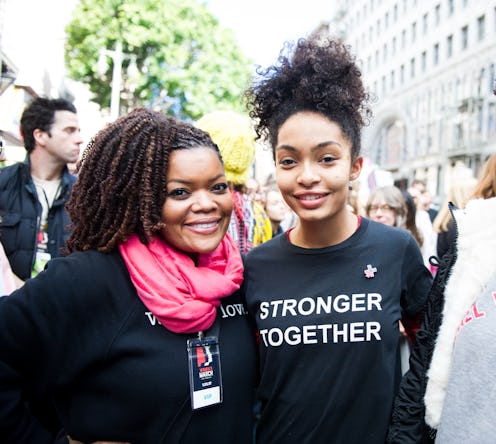
Over the weekend, it appears that Google searches for "intersectional feminism" skyrocketed, according to Google Trends data. So, what is intersectional feminism, and why are people talking about it now? The phrase has a long history, but it's become all the more urgent in today's political climate.
Kimberlé Williams Crenshaw first used the term in a 1989 essay called "Demarginalizing the Intersection of Race and Sex: A Black Feminist Critique of Antidiscrimination Doctrine, Feminist Theory and Antiracist Politics." She uses a traffic intersection as an analogy for identity: If an accident takes place there, you can't be sure which road it came from. In the same way, she writes, "if a Black woman is harmed because she is in an intersection, her injury could result from sex discrimination or race discrimination."
So, being an intersectional feminist means not just caring about gender. Crenshaw's original application of the term specifically addressed racial discrimination; in the decades since its coinage, intersectionalism has also grown to include LGBTQ rights, ableism, and other concerns that undermine the equality of all people. The idea is that systems of oppression all intersect; to consider the issue as a whole, we have to consider all the moving parts that belong to it. It's what contemporary feminism absolutely requires to be effective: As Flavia Dzodan now famously wrote in 2011, "My feminism will be intersectional or it will be bullsh*t."
The recent surge in searches may have to do with the Women's March on Washington, which put out a policy platform to ensure it addressed social justice issues beyond simply gender. Although it was also not without its flaws, it was praised for its intersectionality: Its goals included ending racial profiling by police, combatting discrimination against LGBTQ people, and reforming immigration laws.
To get more specific, here are a few other guidelines that any feminist aiming to be intersectional can follow.
1Respect Other Cultures
Some feminists have gotten into trouble for criticizing certain cultural practices as anti-feminist because they were looking at it through their own culture's lens. For example, some have criticized headscarves worn by Muslim women as a way to silence women, without actually listening to Muslim women about why they may choose to wear it themselves. (Many who practice Islam, for instance, view it as a way to take focus off their appearance — which can definitely be feminist.) It's OK to criticize cultural or religious practices, but those critiques need to come from people who are actually members of those communities, rather than from outsiders. We don't get to dictate to others what their cultural practices mean to them, and especially if we're not a part of those cultures in the first place.
2Support All Movements For Equality
Many were frustrated that it took threats to the lives of white women for many Americans to protest; feminists who are white should have been supporting Black Lives Matter and other movements that advocate for other marginalized groups to begin with. Racial injustice, homophobia, ageism, and other issues impact many disadvantaged people and especially women and non-binary people, so they are feminist issues. To ignore them is to fall prey to White Feminism — and again, feminism must be intersectional, or it is bullsh*t.
3Be Inclusive
Privileged feminists may unintentionally create environments that are only welcoming to white, financially well-off, cisgender, able-bodied, straight, straight-size women. This can happen through the use of ableist or cissexist language, presuming what gender people identify with, assuming people have enough money to accomplish what you're asking of them, and outright shaming certain groups. Read feminist writing by a diverse group of people, follow feminists of all different identities on social media, and and watch speeches by intersectional feminists to better understand the different needs of different people.